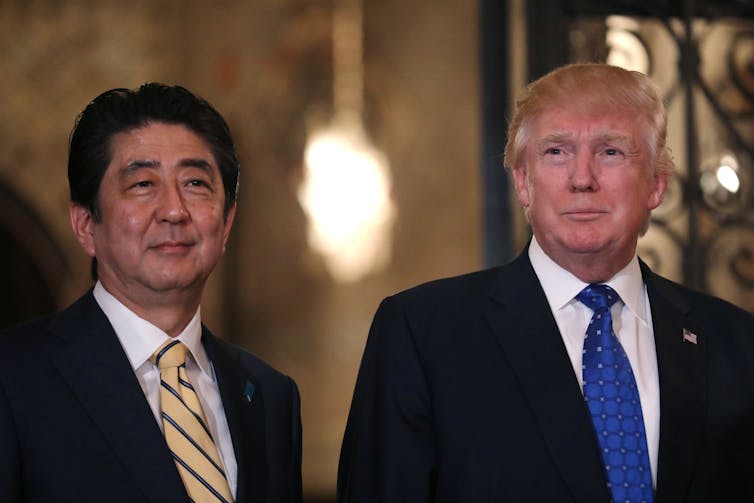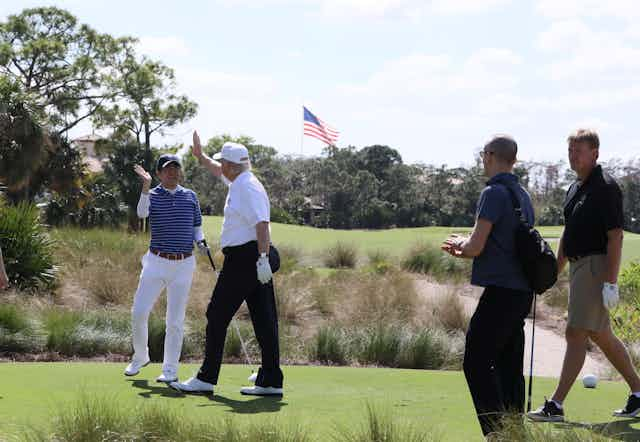Japanese Prime Minister Shinzo Abe managed to be the first foreign leader to visit then president-elect Donald Trump last November. He was already embarking on his activist personal diplomacy to counter the bellicose rhetoric Trump occasionally aimed at Japan during his election campaign, accusing the country of unfair trade practices and currency manipulation, and threatening tariffs against imports.
Trump even implied an end to the US-Japan alliance, stating that Japan, along with other US allies, should develop its own nuclear weapons. But Abe’s first official meeting with President Trump last week – the second world leader after British Prime Minister Theresa May – has already achieved Japan’s most fundamental diplomatic goal: ensuring the continuity its security alliance with America.
The trip follows a successful preliminary visit to Japan the previous week by the US Secretary of Defense James Mattis, and a similarly positive phone call between Japanese Foreign Minister Fumio Kishida and US Secretary of State Rex Tillerson.
Mattis praised the country’s financial contribution to the hosting of US bases in Japan (around 75%, with most bases in Okinawa) as a “model of cost-sharing”. And he issued a statement that the US would continue to defend Japan’s claims over the Senkaku Islands in the East China Sea (claimed as the Daioyus by China), under the US-Japan Security Treaty.
Maintaining the status quo
Reassured by his firm endorsement of the value of Japan’s contribution to the expense of the alliance, the first stage of Abe’s trip to the US produced exactly what was hoped for. In a joint press conference following talks after Abe’s arrival in Washington DC, Trump said:
We are committed to the security of Japan and all areas under its administrative control and to further strengthening our crucial alliance. The bond between our two nations and the friendship between our two peoples runs very, very deep. This administration is committed to bringing those ties even closer.
A joint statement released afterwards confirmed the US remains committed to defending Japan’s claims over the Senkaku Islands under Article 5 of the US-Japan Security Treaty, including use of conventional and nuclear military capabilities, if necessary.
The controversial relocation of the main US military air base on Okinawa will also continue. While maintaining rights to international freedom of flight and navigation in the East China Sea, Abe and Trump also hoped any actions that would escalate tensions in the South China Sea could be avoided.

But, in the first such encounter under the Trump administration, the US Navy has already reported an “unsafe interaction” between one of its reconnaissance aircraft and a Chinese aircraft during a patrol over the South China Sea.
And this is despite Trump having followed up his greeting letter to Xi Jinping, where he expressed hope they can work productively together, with his first phone call to the Chinese leader. During the call, he reiterated the USA’s long-held adherence to the “One China” policy after all.
The problem of trade
Before and during the visit, ignoring criticism from opposition parties in Japan, Abe remained uncritical of Trump’s controversial – and possibly unconstitutional – immigration ban. Abe is hardly in any position to criticise it, given Japan’s own paltry record of accepting refugees. Despite a record number of over 10,000 applications, Japan only accepted 28 refugees in 2016.
North Korea’s first missile launch test of the year, held in the middle of Abe’s US visit, also gave the two leaders an immediate opportunity to display the ongoing strength of the alliance. In a joint news conference, Abe condemned the test as “absolutely intolerable”, while Trump declared “the United States of America stands behind Japan, its great ally, 100%.”
While the defence relationship may have been secured, trade remains the main area of contention. The Trans-Pacific Partnership (TPP), which Japan strongly supported is now likely to be doomed, due to Trump’s condemnation of multilateral trade pacts.
Abe hopes Trump’s hostile campaign rhetoric against Japan over trade can also be mollified.
Appealing to Trump’s populist economic nationalism, Abe brought along a plan called the US-Japan Growth and Employment Initiative. Projected to be worth around US$450 billion, it pledges potential investment by Japanese corporations in the US – in infrastructure, energy, and robots. The package, which promises the creation of more than 700,000 jobs in America over ten years, could be incorporated into a potential bilateral trade deal with Japan.
At their Washington meeting, Abe and Trump agreed to commence talks on a bilateral trade agreement, in place of the TPP. A new US-Japan economic dialogue group is to be established toward that end, to be led by US Vice President Mike Pence and Japanese Deputy Prime Minister Taro Aso, who also held their first separate meeting in Washington.

As with the TPP though, concluding a bilateral trade treaty is likely to be long, complex, fraught process, particularly over agriculture.
Work and play
After the formal Washington meetings, Abe flew to Florida with Trump on Air Force One, accompanied by first ladies Melania Trump and Akie Abe, to the president’s extravagantly luxurious Mar-a-Largo resort, to play golf for the weekend. The White House stated the cost of Abe’s visit to the resort, including golfing fees, would be paid for by Trump as a personal gift.
This is a further sign of the apparently warm personal ties that Abe has managed to cultivate; Trump has already accepted an invitation to visit Japan later this year.
If Abe returns with US trade relations relatively intact, as well as the military alliance, he will have taken advantage of the erratic and turbulent first weeks of the Trump administration to secure favourable strategic and economic relations. His government is likely to be supported by the Trump administration, as it was by president Barack Obama’s, to continue increasing defence spending, and pursuing further constitutional change.
In return, Abe is likely to encourage the US to challenge China’s recent domination of the South China Sea, and compete with the expansion of Chinese influence into the Indian Ocean region, through its planned massive “One Belt, One Road” land and sea transport infrastructure project.
Abe’s US visit could, in fact, eventually turn out to have been an important step in reviving his long-held ambition for a “security diamond” between Japan, the US, India and Australia, which he proposed during his first term as prime minister in 2006-2007.
These four states may now be more willing to revive this idea for a strategic alliance, but if it does proceed, this could threaten a Cold War-style hegemonic confrontation in the Asia-Pacific region. And it could have potentially catastrophic consequences if armed conflict breaks out over territorial disputes.
Abe is one of the most energetic practitioners of diplomacy among modern Japanese prime ministers. By flattering Trump’s ego, he has proved adept at handling Trump’s inexperience in foreign policy. He has managed to successfully challenge one of Trump’s strongest held attitudes, publicly expressed as long ago as 1987, that the US is being exploited by its allies in providing for their military protection.
Abe has demonstrated to other world leaders how to approach President Donald Trump: pay the price to strike a deal that panders to corporate interests and geostrategic nationalism of both sides.
This first official US visit has thus potentially become Abe’s most far-reaching diplomatic achievement so far. That is, if the notoriously temperamental, inconsistent and contradictory Trump can be counted on to stick to his deals.

